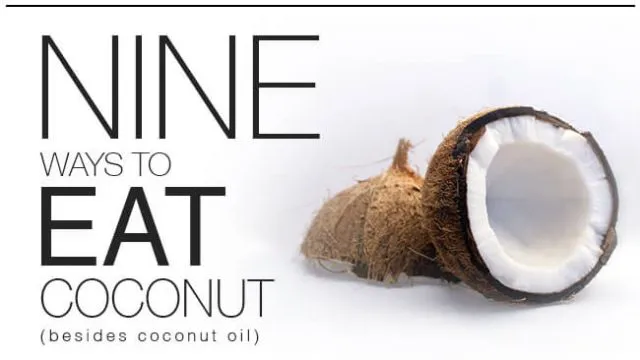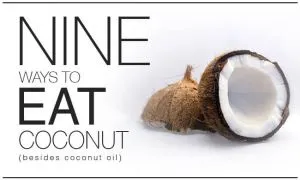
- Share on Facebook233
- Share on Pinterest
- Share on Twitter
We talk a lot about coconut oil here at The Alternative Daily. It’s one of the best forms of good fat, and has so many other awesome health-promoting properties. But did you know that there are many other foods that come from the humble coconut? This simple tropical fruit offers up a truly incredible number of delicious and nutritious products for us to enjoy.
Don’t sell yourself short by just consuming coconut oil — try all of the other tasty offerings too!
Coconut butter/manna
Coconut butter is basically coconut puree. As opposed to coconut oil, where the fat is pressed from the coconut flesh, coconut butter still has the fibrous component of the flesh left in. The result is a dreamy treat with a fudge-like texture and amazing flavor.
Coconut butter is highly nutritious thanks to the balance of healthy fat and fiber. Here at The Alternative Daily, we recognize that natural, minimally processed plant and animal fats are a vital part of a nutrient dense diet. Therefore we recommend coconut butter as a great snack choice for those times when you’re feeling a little bit peckish or want something sweet.
It satisfies a sweet tooth without raising your blood sugar, because the small amount of sugar is negated by the fiber content. Besides having coconut butter as a healthy high-fat snack, also try mixing it into baked goods or homemade ice-cream.
Note that this is not the same thing as cocoa butter. Cocoa butter is an edible vegetable fat made from cocoa beans and used in sweets and cosmetic products.
The best choice is unsweetened organic coconut butter. If you can’t find a good quality product at your local store, it’s fairly easy to make your own. All you need is quite a bit of desiccated coconut and a food processor.
Simply fill your food processor about halfway or two thirds full of unsweetened desiccated coconut. (Check for a brand that doesn’t have any oils added, as some will contain vegetable or soybean oil)
Start the food processor slowly, then speed up and process the coconut flesh for about thirty seconds. Stop when you notice the mixture begins to stick to the sides of the food processor. Scrape down the sides back into the bowl, and process again. Repeat until all of the coconut flesh is processed into thick, delicious butter. Scoop it out into a jar and store in the pantry, no refrigeration required. That’s it!
You may find that, during storage, the oil separates from the flesh of the coconut and hardens on top. This is completely normal — just put the jar in a warm place or run some hot water over it for a minute or so. The oil will soften — then you can mix it back into the butter.
Desiccated coconut
This is the type of coconut that is often used in desserts, such as squares and macaroons. However, it is often mixed with unnecessary unhealthy ingredients, such as vegetable oil and sugar. If you buy an organic unsweetened variety, you can enjoy the pure dried coconut flesh with no guilt!
Try toasting desiccated coconut on a pan in the oven until it is slightly golden to bring out a delicious caramel flavor. Also look for “flaked” or “shaved” dried coconut, which comes in larger curls — these are perfect for adding to homemade granola or trail mix.
Coconut sugar
Another delicious product made from the coconut palm is its sugar, which is made from the sap. It has a smoky caramel flavor and a pretty golden color. Some say it is healthier than cane sugar because it is less processed and registers lower on the glycemic index.
Coconut sugar also contains less fructose, only about six percent. Fructose is said to be difficult for the liver to process. Although coconut sugar may be a smarter choice for a sweetener, it should still be enjoyed in moderation.
Fresh coconut and young coconut
Fresh coconut flesh makes a delicious snack or dessert. It takes a little bit of effort to crack a coconut yourself, however many supermarkets sell containers of fresh coconut, which make for a convenient solution.
If you choose to buy and open your own coconut, here is the method:
When shopping for a coconut, be sure to pick it up and shake it. It should be heavy with an audible amount of liquid sloshing around on the inside. If it doesn’t have liquid inside, the coconut is probably old and dried out.
- At home, set up a soft surface on the floor. A folded towel works great. It’s better to work on the floor so that if the coconut is difficult to control, less damage is likely. It is also less apt to roll around and get away from you.
- Grab a hammer and nail. Find the dots on the coconut that make it look like a bowling ball. These parts are weaker, so they are the best place to start trying to puncture the coconut.
- Once you’ve made one hole, wiggle the nail around to work your way through the flesh. Now place the coconut on top of a cup with the hole facing down to let the water inside run out. If the water won’t come out, try expanding your nail hole, adding another one at the same end of the coconut, and/or carefully nailing another small hole into the opposite end of the coconut to allow for the entry of air.
- Let the water drain fully — it might take several minutes. You can drink the delicious fresh coconut water!
- Now wrap the coconut in the towel and place the package on a hard floor that is resistant to damage. Carefully hold the package and knock the coconut firmly with the hammer as many times as needed. The goal is to break the shell into several manageable pieces.
- Now you can remove the white flesh from inside the thicker shell. The flesh will still have a thin brown skin stuck to it — this is okay to eat. Eat immediately or store in the fridge in a sealed container for no more than three days.
Young coconuts are softer and easier to open. Simply put the coconut on its side and use a regular chef’s knife to carve away the thick white rind from the pointed end. Then puncture the inner shell and cut a circular “lid,” which you can then pry off. Scoop out the soft gel-like inner flesh and drink the fresh juice inside!
Coconut water
Coconut water is the liquid that comes out of the fresh coconut. It is slightly sweet and very tasty, plus it is one of the best sources of natural hydration! The sugars, minerals and salts that come from coconut water are very nourishing to the body, so it is essentially a real-food sports beverage. Try it over ice on a hot day, or make ice pops out of it!
Coconut milk and cream
These creamy delights are made by expressing the liquid and fat from within coconut flesh. Coconut milk has less fat and can be poured, whereas coconut cream is thick enough that you have to scoop it with a spoon. Both are excellent sources of healthy fat.
We recommend avoiding any “light” or low-fat varieties of coconut milk, since these are usually thickened with food additives like guar gum or carrageenan. It’s better to consume and enjoy the fat from the coconut in its natural state.
If you don’t digest dairy well, coconut milk or cream is an excellent option to have with your coffee, tea or homemade granola. It also works great in recipes, such as grain-free pancakes, loaves and muffins.
Coconut yogurt
Did you know that yogurt can be made from coconut milk? It is made using a similar process to regular yogurt, but makes a great non-dairy choice. When shopping, stick with brands that have fewer ingredients and little sugar added. Better yet, try making your own!
Coconut kefir
Coconut kefir boasts an even greater dose of probiotics as compared to yogurt. It is made with simple coconut milk or coconut water that has been cultured with kefir grains. The probiotic yeast and bacteria consume the sugars in the coconut milk and thicken it into kefir.
If you have your own kefir grains, you must alternate between batches of coconut milk and regular cow’s milk, since the grains can only live in coconut milk for a limited time.
Take some dried coconut flesh and grind it up, and you’ve got coconut flour! This is a great high-fiber, grain-free flour that you can use for all of your grain-free baking.
Be aware that coconut flour soaks up a lot of moisture and has a crumbly texture. Therefore you only need to use a little bit in recipes, and more eggs are often needed to hold the finished product together.
We recommend referencing existing recipes and not simply swapping coconut flour for regular flour! It might take a little bit of experimentation to get a feel for it, but after a few tries, you’re sure to find that coconut flour makes delicious flavorful baked goods with a pleasant natural sweetness.
Next time you visit the supermarket or health food store, keep your eyes peeled for some of these delicious coconut products that you might not be familiar with. If you can’t find them at the store, try ordering them online, or even making your own!
Did you know that coconut is just as good for you on the outside (on your hair and skin) as it is on the inside? We love using coconut oil to make natural hair products and even DIY skincare concoctions!
— Liivi Hess
Liivi is an Integrative Nutrition Health Coach and is training to become a doula. She inspires women to find peace and personal power by taking control of health and fertility naturally. Liivi‘spassion is ancestral nutrition and primal lifestyle design. She and her partner Will live between Toronto, Canada and Queenstown, New Zealand.
Sources:
http://www.sciencedirect.com/science/article/pii/S1466856406000452
http://www.cabdirect.org/abstracts/19836749770.html;jsessionid=FCE0EBBC8A5AB9A49A1F45E3490AD853
http://online.liebertpub.com/doi/abs/10.1089/1096620041224148
http://www.diabetes.org/food-and-fitness/food/what-can-i-eat/making-healthy-food-choices/coconut-palm-sugar.html
http://www.theglobeandmail.com/life/health-and-fitness/ask-a-health-expert/coconut-sugar-is-it-healthier-than-white-sugar-or-just-hype/article19187927
http://www.bbcgoodfood.com/howto/guide/ingredient-focus-coconut-milk
http://journals.cambridge.org/action/displayAbstract?fromPage=online&aid=911232&fileId=S0007114503001594
- Share on Facebook233
- Share on Pinterest
- Share on Twitter


